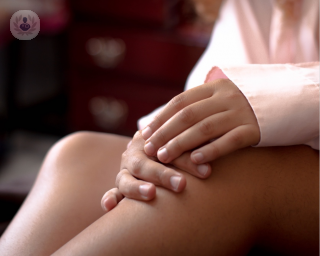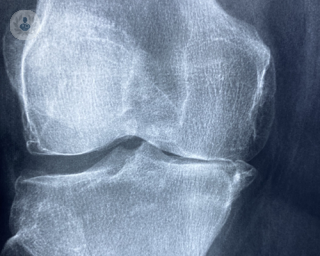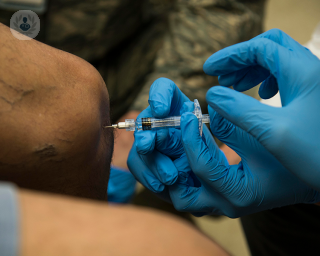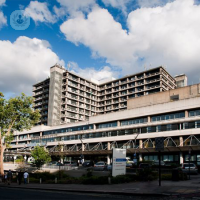What is joint pain?
Joint pain refers to pain, discomfort and soreness in the joints. Joints are the parts of your body where bones meet. They allow your bones to move. Joints include the shoulders, elbows, hips and knees. Joint pain can be the result of damage that occurs through normal wear-and-tear, or it can be a sign of an infection or an underlying condition such as rheumatoid arthritis.

What are the symptoms of joint pain?
Symptoms of joint pain include:
- Swelling, redness and tenderness around the joint
- Pain persisting for three days or longer
- Fever symptoms without the flu
You should seek emergency care if the following symptoms are present:
- Joint deformity
- Swelling that occurs suddenly without reason
- If you have had an injury or fall
- You cannot move your joint
- You have extreme pain
How is joint pain diagnosed?
Your doctor performs a physical exam. A joint X-ray may be carried out to look at the joint damage. A blood test may be performed to detect if there is an autoimmune disorder.
What causes joint pain?
Joint pain is usually caused by diseases such as osteoarthritis and rheumatoid arthritis, and sometimes it is caused by an illness or an injury. Osteoarthritis is one of the most common causes of joint pain, and is mostly found among adults over the age of 40. Osteoarthritis affects the wrists, hands, hips and knees. The disease results from the breakdown of cartilage which acts a shock absorber and cushions joints.
Rheumatoid arthritis affects more women than men and causes pain, inflammation and a build-up of fluid in the joints because the body’s immune system is attacking itself.
Other causes of joint pain include:
- Lupus
- Gout
- Bursitis
- Infectious diseases such as mumps, influenza and hepatitis
- Chondromalacia of the kneecap
- Tendonitis
- Overusing joints
- Cancer
- Rickets
- Osteoporosis
- Fibromyalgia
- Sarcoidosis
How can joint pain be treated?
Treatment will depend on the cause of the pain. Fluid may need to be removed from joints to test for infection or other causes of joint pain. In some instances, surgery to replace the joint may be necessary.
There is no treatment currently available to treat osteoarthritis and rheumatoid arthritis, but the pain caused by these conditions can be managed with:
- Topical pain relievers
- Nonsteroidal anti-inflammatory drugs to reduce pain, swelling and inflammation
- Moderate exercise
- Stretching to keep joints mobile and flexible
- Maintaining a healthy weight, as this puts less pressure on your joints
- Getting adequate rest
- Taking a warm bath or having a massage can also help
Joint pain
Dr Elena Nikiphorou - Rheumatology
Created on: 11-13-2012
Updated on: 11-14-2024
Edited by: Carlota Pano
What is joint pain?
Joint pain refers to pain, discomfort and soreness in the joints. Joints are the parts of your body where bones meet. They allow your bones to move. Joints include the shoulders, elbows, hips and knees. Joint pain can be the result of damage that occurs through normal wear-and-tear, or it can be a sign of an infection or an underlying condition such as rheumatoid arthritis.

What are the symptoms of joint pain?
Symptoms of joint pain include:
- Swelling, redness and tenderness around the joint
- Pain persisting for three days or longer
- Fever symptoms without the flu
You should seek emergency care if the following symptoms are present:
- Joint deformity
- Swelling that occurs suddenly without reason
- If you have had an injury or fall
- You cannot move your joint
- You have extreme pain
How is joint pain diagnosed?
Your doctor performs a physical exam. A joint X-ray may be carried out to look at the joint damage. A blood test may be performed to detect if there is an autoimmune disorder.
What causes joint pain?
Joint pain is usually caused by diseases such as osteoarthritis and rheumatoid arthritis, and sometimes it is caused by an illness or an injury. Osteoarthritis is one of the most common causes of joint pain, and is mostly found among adults over the age of 40. Osteoarthritis affects the wrists, hands, hips and knees. The disease results from the breakdown of cartilage which acts a shock absorber and cushions joints.
Rheumatoid arthritis affects more women than men and causes pain, inflammation and a build-up of fluid in the joints because the body’s immune system is attacking itself.
Other causes of joint pain include:
- Lupus
- Gout
- Bursitis
- Infectious diseases such as mumps, influenza and hepatitis
- Chondromalacia of the kneecap
- Tendonitis
- Overusing joints
- Cancer
- Rickets
- Osteoporosis
- Fibromyalgia
- Sarcoidosis
How can joint pain be treated?
Treatment will depend on the cause of the pain. Fluid may need to be removed from joints to test for infection or other causes of joint pain. In some instances, surgery to replace the joint may be necessary.
There is no treatment currently available to treat osteoarthritis and rheumatoid arthritis, but the pain caused by these conditions can be managed with:
- Topical pain relievers
- Nonsteroidal anti-inflammatory drugs to reduce pain, swelling and inflammation
- Moderate exercise
- Stretching to keep joints mobile and flexible
- Maintaining a healthy weight, as this puts less pressure on your joints
- Getting adequate rest
- Taking a warm bath or having a massage can also help


Joint soft tissue pain: a comprehensive, expert overview
By Dr Shabaaz Mughal
2025-01-28
Joint soft tissue pain, if left untreated for a prolonged period of time, can become chronic. Here to inform how we can avoid allowing this to happen is highly experienced and well-regarded London-based consultant sport and medicine physician, Dr Shabaaz Mughal. See more


Types of injections for joint pain
By Mr Rohit Jain
2025-01-28
When it comes to treating inflammatory joint conditions there are many ways of treating them. If you suffer from this condition, it's essential that you chat with an expert to ensure you treat the condition appropriately. We spoke with leading orthopaedic hip and knee surgeon, Mr Rohit Jain, to find out information on joint injections, the different types and how long their effects can last for. See more


What's involved in an Arthroplasty?
By Mr Ricci Plastow
2025-01-28
Arthroplasty, also referred to joint replacement surgery, is a procedure where a damaged joint is replaced with an artificial implant. Here to provide a detailed look at what’s involved in this procedure, is leading trauma and orthopaedic surgeon Mr Ricci Plastow. See more


Lipogems and osteoarthritis: a patient guide
By Dr Ralph Rogers
2025-01-28
One of the latest advances in regenerative medicine, Lipogems injections, is now available at an increasing number of clinics across the UK, promising a new way to treat osteoarthritis without surgery. In this article, leading sports medicine specialist Dr Ralph Rogers has written a patient guide to Lipogems, covering how it works, who it’s suitable for, and how long the results last. See more
Experts in Joint pain
-
Dr Ian Beasley
Sports medicineExpert in:
- Sports injuries
- Sports physical examination
- Sports medicine
- Sports traumatology
- Muscle injuries
- Joint pain
-
Dr Anthony Ordman
Pain medicineExpert in:
- Neuropathic pain
- Musculoskeletal pain
- Joint pain
- Cancer Pain
- Chronic pain
- Reflex sympathetic dystrophy syndrome (RSD)
-
Dr Kiran Sachane
Pain medicineExpert in:
- Back pain
- Neuropathic pain
- Neck pain
- Migraine
- Sciatica
- Joint pain
-
Dr Sumit Gulati
Pain medicineExpert in:
- Radiofrequency denervation
- Sciatica
- Joint pain
- Neuropathic pain
- Pelvic pain
- Back pain
-
Dr Martynas Juozaitis
Pain medicineExpert in:
- Pain treatment
- Musculoskeletal pain
- Stem cells
- Platelet-rich plasma
- Knee
- Joint pain
- See all

TIC Health The Hive
TIC Health The Hive
Camrose Avenue
No existe teléfono en el centro.
By using the telephone number provided by TOP DOCTORS, you automatically agree to let us use your phone number for statistical and commercial purposes. For further information, read our Privacy Policy
Top Doctors

TIC Health Harley Street
TIC Health Harley Street
112 Harley Street
No existe teléfono en el centro.
By using the telephone number provided by TOP DOCTORS, you automatically agree to let us use your phone number for statistical and commercial purposes. For further information, read our Privacy Policy
Top Doctors

The Royal Free Hospital
The Royal Free Hospital
Pond Street, Hampstead. NW3 2QG
No existe teléfono en el centro.
By using the telephone number provided by TOP DOCTORS, you automatically agree to let us use your phone number for statistical and commercial purposes. For further information, read our Privacy Policy
Top Doctors
-
TIC Health The Hive
Camrose Avenue, West LondonExpert in:
- Adult Diabetes
- Child Diabetes
- Hypertension
- Hand and wrist
- Joint replacement
- Health check up
-
TIC Health Harley Street
112 Harley Street, Central LondonExpert in:
- Preventive cardiology
- Diagnostic Imaging
- Physiotherapy
- General practice
- GP (general practitioner)
- Osteopathy
-
The Royal Free Hospital
Pond Street, Hampstead. NW3 2QG, Central LondonExpert in:
- General Surgery
- Orthopaedic surgery
- Robotic Surgery
- Dermatology
- Obstetrics and Gynaecology
- Paediatrics
- See all
- Most viewed diseases, medical tests, and treatments
- Respiratory infection
- Menopause support
- Trigeminal neuralgia
- Immunotherapy
- Alzheimer's disease
- Cluster headaches
- Tension headache
- Chronic headache
- Peripheral nerve block
- Child nutrition








